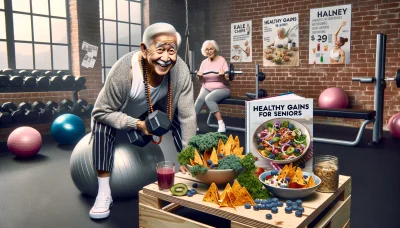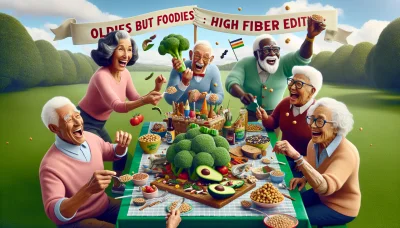Senior nutrition program Quiz
Test Your Knowledge
Question of
Understanding Senior Nutrition Programs
Importance of Nutrition in Aging
Nutrition plays a pivotal role in the health and well-being of older adults, impacting their quality of life significantly. As we age, our bodies undergo changes that can affect appetite, metabolism, and nutrient absorption, making proper nutrition even more crucial.
Preventing malnutrition is paramount for seniors. Inadequate intake of nutrients can lead to weakened muscles, increased risk of fractures, and prolonged recovery times from illness. A focus on nutrient-rich foods is essential to combat these risks.
Enhancing immune function through diet is a game-changer for seniors. The right nutrients can bolster the immune system, helping to fend off illnesses and infections that older individuals are more susceptible to.
Supporting mental health through nutrition cannot be overstated. Certain vitamins and minerals have been linked to cognitive function and may help delay or prevent the onset of age-related mental decline.
Key Components of a Senior Nutrition Program
A balanced diet guideline is at the heart of any senior nutrition program. It ensures that seniors receive the right mix of proteins, carbohydrates, fats, and fibers needed to maintain their health.
Hydration and fluid intake are often overlooked but are critical components of senior nutrition. Older adults are less likely to feel thirsty, which can lead to dehydration and its associated complications.
Vitamin and mineral requirements for seniors differ from those of younger adults. Increased needs for calcium, vitamin D, B12, and other nutrients are common in the elderly population to support bone health and energy levels.
- Balanced Diet: Include a variety of fruits, vegetables, whole grains, lean protein, and low-fat dairy products.
- Regular Meals: Encourage eating at regular intervals to maintain energy levels throughout the day.
- Social Eating: Promote communal dining experiences which can stimulate appetite and improve food intake.
- Fiber Intake: Ensure adequate fiber consumption to promote digestive health.
- Suitable Textures: Adapt food textures in accordance with any dental or swallowing difficulties.
- Sugar & Salt Moderation: Limit intake of excessive sugar and salt to prevent or manage chronic conditions.
- Hydration Habits: Create consistent hydration habits by including fluids throughout the day beyond just meal times.
- Nutrient-Dense Snacks: Offer snacks rich in nutrients between meals if total daily energy intake is insufficient.
- Educational Resources: Provide access to nutrition education materials tailored for seniors.
Accessing Senior Nutrition Services
Community-based programs play a critical role in delivering nutrition services to seniors. These programs offer nutritious meals along with opportunities for social interaction which can be beneficial for overall health.
Home-delivered meals are a lifeline for homebound seniors or those with mobility issues. These services ensure that seniors do not miss out on nutritious meals despite their limitations in accessing food outside their home.
The government-funded initiatives serve as safety nets for seniors facing financial constraints. Programs like Meals on Wheels or SNAP provide essential support in ensuring access to healthy foods for all older adults regardless of income level.
Tailoring Diets to Age-Related Changes
Adapting to Altered Taste and Smell
As we age, our sense of taste and smell may diminish, leading to a decreased appetite and potential nutritional deficiencies. It's crucial to adapt our diets to these changes to maintain a balanced intake of essential nutrients. Enhancing the flavor profile of meals without over-relying on salt or sugar can help stimulate appetite and improve overall enjoyment of food.
Flavor Enhancement Techniques involve using herbs, spices, and natural flavor enhancers like lemon juice or vinegar to make food more palatable. Experimenting with different seasonings can transform bland meals into exciting culinary experiences, even for those with diminished taste buds.
Managing Sensory Loss requires creative approaches to meal preparation. Incorporating a variety of textures and colors can make meals visually appealing and compensate for some sensory deficits. It's also important to ensure that the environment is conducive to eating, with minimal distractions and pleasant settings.
Nutrient-Dense Food Selection is paramount when taste and smell are impaired. Opt for foods rich in vitamins, minerals, and antioxidants, such as leafy greens, colorful fruits, lean proteins, and whole grains. These choices help meet nutritional needs while also offering diverse flavors and aromas.
Addressing Digestive System Changes
The digestive system often becomes less efficient with age, which can lead to issues such as constipation or indigestion. Adjusting the diet to include easy-to-digest foods that are gentle on the stomach is essential for maintaining digestive health.
Easy-to-Digest Foods include well-cooked vegetables, ripe fruits without skin, grains like rice and oatmeal, and lean proteins such as fish or poultry. These foods minimize digestive strain while providing necessary nutrients.
Fiber-Rich Diet for Digestive Health is critical for preventing constipation a common concern among older adults. Sources of fiber include whole grains, legumes, fruits, and vegetables. However, it's important to increase fiber intake gradually and maintain adequate hydration.
- Probiotics and Gut Health:
- Incorporate fermented foods like yogurt, kefir, or sauerkraut that contain probiotics.
- Eat prebiotic-rich foods such as garlic, onions, bananas, and oats that feed beneficial gut bacteria.
- Avoid excessive use of antibiotics which can disrupt gut flora balance.
- Maintain regular eating schedules to support consistent digestive processes.
- Lifestyle factors such as stress management and physical activity also play a role in gut health.
Coping with Chewing or Swallowing Difficulties
Dysphagia difficulty in swallowing is another age-related challenge that can significantly affect nutrition. Adapting dietary choices to include softer foods that are easier to chew and swallow can help manage this condition effectively.
Soft Food Diets might consist of mashed potatoes, pureed fruits and vegetables, cottage cheese, scrambled eggs, or soups. These options provide necessary nutrients while being gentle on the chewing mechanism.
Swallowing Therapy and Techniques , often guided by speech-language pathologists or healthcare professionals specializing in dysphagia management can offer strategies for safer eating. Simple adjustments in posture or specific swallowing techniques can make a significant difference in mealtime experiences.
Nutritious Liquid Meal Options , such as smoothies or meal replacement shakes enriched with vitamins and protein can be an excellent alternative for those who find solid foods challenging. They should be well-balanced to ensure that all dietary needs are met despite the liquid form.
Special Diets for Senior Health Conditions
Heart-Healthy Eating Plans
As we age, a heart-healthy diet becomes increasingly important to reduce the risk of cardiovascular diseases. Such a diet focuses on balancing nutrient-rich foods with moderate portions, aiming to sustain a healthy blood pressure and cholesterol level. It's not just about what you eat, but also about the overall pattern of your dietary choices that contribute to your heart's well-being.
Low Sodium Options: High sodium intake is linked with high blood pressure, a major risk factor for heart disease. Seniors should opt for fresh vegetables, fruits, lean proteins, and whole grains that are naturally low in sodium. Seasoning foods with herbs and spices rather than salt can make a significant difference in sodium intake without sacrificing flavor.
Cholesterol-Lowering Foods: Certain foods can help lower cholesterol levels naturally. These include options rich in soluble fiber, like oats and legumes, which bind cholesterol in the digestive system and remove it from the body. Including nuts and seeds that are high in unsaturated fats can also contribute to maintaining healthy cholesterol levels.
Incorporating Omega-3 Fatty Acids: Omega-3 fatty acids are crucial in preventing heart diseases by reducing inflammation throughout the body. Cold-water fish like salmon, mackerel, and sardines are excellent sources of omega-3s. For those who do not consume fish, flaxseeds and walnuts are great plant-based alternatives.
Diabetes-Friendly Meal Planning
Effectively managing diabetes through diet involves maintaining consistent blood sugar levels. This is achieved by understanding how foods affect blood sugar and making informed choices to avoid spikes and dips. A balanced diabetes-friendly diet includes a variety of nutrients while limiting sugars and refined carbohydrates.
Carbohydrate Counting Basics: Carbohydrates have the most immediate effect on blood glucose levels. Learning to count carbohydrates and distributing them evenly throughout the day helps in keeping blood sugar levels stable. Whole grains, fruits, vegetables, and legumes should be preferred over processed carbs for better control over diabetes.
Glycemic Index and Meal Timing: The glycemic index (GI) ranks food based on how quickly they raise blood sugar levels. Seniors with diabetes should incorporate low-GI foods into their meals as they cause a slower rise in glucose levels. Additionally, consistent meal timing assists in maintaining stable blood sugar throughout the day.
- Avoid skipping meals to prevent hypoglycemia.
- Prioritize fiber-rich foods for better glycemic control.
- Maintain hydration but be cautious with sugary drinks.
- Educate yourself on portion sizes to avoid overeating carbs.
- Monitor blood sugar levels regularly to understand how different foods affect you personally.
Bone-Strengthening Diet Strategies
Bone health is critical for seniors to prevent fractures and diseases such as osteoporosis. A bone-strengthening diet emphasizes adequate intake of essential nutrients that support bone density and structure. This dietary approach goes hand-in-hand with an active lifestyle to maintain strength and mobility into older age.
Calcium-Rich Foods: Calcium is fundamental for bone health; thus, seniors need to include sources of calcium in their diet daily. Dairy products like milk, cheese, and yogurt are well-known calcium sources; however, leafy greens and fortified plant milks provide alternatives for those with lactose intolerance or dairy allergies.
Vitamin D Sources and Sunlight Exposure: Vitamin D aids in calcium absorption which is vital for bone health. While sunlight exposure is one way to get vitamin D, food sources such as fatty fish, egg yolks, and fortified cereals can help meet dietary requirements especially for those with limited sun exposure or during winter months.
Weight-Bearing Exercises for Bone Health: Alongside a nutritious diet, engaging in weight-bearing exercises stimulates bone formation and strength. Activities such as walking, dancing or light weightlifting can be particularly beneficial for seniors looking to protect their skeletal health while improving overall fitness.
Nutritional Needs for Active Seniors
Fueling Exercise and Physical Activity
Active seniors need a balanced diet to support their energy levels. It's crucial to focus on nutrient-dense foods that provide the energy necessary for exercise without causing unwanted weight gain. Complex carbohydrates like whole grains, legumes, and vegetables are excellent sources of sustained energy.
Pre-Exercise Meals and Snacks should be timed appropriately, usually about 1-3 hours before physical activity. These meals should combine carbohydrates with moderate protein to fuel muscles and delay fatigue. Quick options like a banana with peanut butter or a small bowl of oatmeal with berries can make all the difference.
Hydration During Physical Activity is essential to maintain performance and prevent dehydration. Seniors should drink water throughout the day, especially before, during, and after exercise. The goal is to replace fluids lost through sweat, which can be monitored by checking urine color - pale yellow indicates proper hydration.
Recovery Nutrition Post-Exercise involves replenishing glycogen stores and repairing muscle tissue. A meal or snack rich in carbohydrates and protein within 45 minutes post-exercise can help in recovery. A glass of chocolate milk or a turkey sandwich on whole-grain bread are both perfect recovery food choices.
Protein Intake for Muscle Maintenance
As we age, maintaining muscle mass becomes a top priority. Protein plays a pivotal role in preserving muscle tissue, especially for active seniors engaging in resistance training. A daily intake of 1.0-1.2 grams of protein per kilogram of body weight is often recommended.
High-Quality Protein Sources include lean meats, poultry, fish, eggs, dairy products, legumes, nuts, and seeds. These foods provide essential amino acids that are vital for muscle repair and growth.
The debate between Plant-Based vs. Animal Protein often comes down to personal preference and dietary restrictions. While animal proteins are complete sources (containing all essential amino acids), plant-based proteins can also meet needs when consumed in variety and adequate amounts.
Protein Supplements: Pros and Cons : Supplements like whey or plant-based powders can be beneficial for those struggling to meet protein requirements through food alone. However, they should not replace whole foods entirely due to the lack of additional nutrients found in natural food sources.
Balancing Calories for Weight Management
Understanding Metabolic Rate Changes is critical as we age because our metabolic rate naturally slows down. Active seniors must adjust their caloric intake accordingly to prevent weight gain while still consuming enough calories to fuel their activity levels.
- Portion Control Tips:
- Eat from smaller plates to naturally reduce portion sizes without feeling deprived.
- Prioritize high-fiber foods which promote satiety with fewer calories.
- Avoid eating straight from large packages; instead serve yourself a measured amount.
- Tune in to hunger cues and eat slowly to recognize fullness signals better.
Healthy Snacking Habits play a significant role in weight management for active seniors. Opting for snacks that are high in fiber and protein can help control hunger between meals without adding excessive calories think Greek yogurt with fruit or a handful of almonds with an apple.
Overcoming Common Dietary Challenges in Seniors
Managing Appetite Fluctuations
Appetite fluctuations in seniors can be concerning, but they're not insurmountable. It's essential to understand that changes in appetite could be due to a variety of factors, including medications, emotional well-being, or physical health issues. Tackling these can help stabilize appetite.
Creating an inviting eating environment can play a crucial role in enhancing appetite. A well-set table with colorful foods can make meals more appealing. Additionally, socializing during mealtimes can stimulate the desire to eat and improve overall food intake.
Stimulating Appetite Naturally
To naturally stimulate appetite, encourage regular physical activity as it can increase hunger hormones. Also, consider serving smaller, nutrient-dense snacks throughout the day instead of relying solely on traditional meal times which can be overwhelming.
Meal Scheduling Strategies
Consistency is key when managing appetite fluctuations. Establishing fixed meal times helps regulate the body's hunger cues. If large meals are daunting, opt for five to six smaller meals spread throughout the day to maintain energy levels and nutrient intake.
Mindful Eating Practices
Mindful eating practices encourage seniors to focus on their meal and savor each bite, which can enhance appetite and digestion. It's about creating a calm atmosphere at mealtime, free from distractions like television or distressing topics of conversation.
Ensuring Adequate Fiber Intake
Fiber is a non-negotiable part of a senior's diet due to its immense benefits for digestive health and chronic disease prevention. However, many seniors struggle with consuming adequate amounts due to changes in taste preferences or dental issues.
High-Fiber Foods for Seniors
- Whole grains such as oatmeal or quinoa provide substantial fiber without being too harsh on the digestive system.
- Fruits and vegetables should be a stapleeither fresh, cooked, or as smoothiesto meet daily fiber needs effortlessly.
- Legumes like lentils and beans are not only high in fiber but also excellent protein sources that are senior-friendly.
- Nuts and seeds can be incorporated into diets as snacks or toppings for added texture and nutrients along with fiber.
Balancing Fiber with Digestive Comfort
Incorporating fiber gradually into the diet is essential for avoiding gastrointestinal discomfort. Pairing high-fiber foods with plenty of fluids ensures smoother digestion and prevents constipationa common concern among seniors.
Fiber Supplements: When Necessary?
Fiber supplements may become necessary when dietary changes alone do not suffice. They should be used judiciously under medical supervision to avoid any adverse effects on nutrient absorption or medication interactions.
Dealing with Dietary Restrictions and Allergies
Dietary restrictions and allergies present unique challenges but don't have to limit nutritional adequacy. Understanding these limitations and finding creative ways to work around them ensures that seniors still receive all the necessary nutrients for optimal health.
Identifying and Avoiding Allergens
It is critical first to identify any potential allergens through allergy testing or elimination diets under professional guidance. Once identified, these allergens must be consistently avoided by checking food labels meticulously or preparing meals at home where possible.
Alternative Nutrient Sources
Finding alternative sources of nutrients becomes imperative when dealing with allergies. For instance, if dairy is off-limits due to lactose intolerance, alternatives like fortified soy milk or almond milk can provide vital calcium and vitamin D without causing discomfort.
Working with a Dietitian
A registered dietitian specializes in creating personalized nutrition plans that cater to dietary restrictions while ensuring balanced nutrition. Their expertise is invaluable in navigating the complexities of food allergies and restrictions in elderly individuals.
The Role of Supplementation in Senior Diets
Identifying Nutrient Deficiencies
As we age, our bodies undergo significant changes that can affect how nutrients are absorbed and utilized. Seniors are particularly susceptible to nutrient deficiencies, which can have profound impacts on health and well-being. Recognizing these deficiencies early is vital to maintain quality of life.
Common Deficiencies in Seniors include vitamin D, calcium, and vitamin B12. These nutrients are crucial for bone health, energy levels, and cognitive function. A lack of these nutrients can lead to serious health issues such as osteoporosis or anemia.
Blood Tests and Nutrient Monitoring are essential tools to identify specific nutrient shortages in seniors. Regular check-ups with healthcare providers allow for tailored dietary recommendations and interventions to correct any imbalances.
Symptoms of Nutritional Deficiencies can range from fatigue and weakness to more severe neurological symptoms. It's important that both seniors and caregivers stay informed about these signs to address potential deficiencies promptly.
Choosing the Right Supplements
Selecting the appropriate supplements can be a game-changer for seniors looking to improve their nutritional intake. With a plethora of options available, it's critical to make informed decisions based on individual health needs.
Multivitamins for Seniors offer a comprehensive solution designed to fill nutritional gaps. They typically contain higher doses of vitamins D and B12, reflecting the increased needs of the older population.
- Tips for Choosing Supplements:
- Consult with a healthcare provider before starting any supplement regimen.
- Evaluate labels for age-specific formulations that cater to senior nutritional profiles.
- Look for third-party testing seals for quality assurance.
- Avoid excessive dosages that can lead to toxicity or adverse effects.
- Consider ease of use, such as liquid forms or smaller pills, if swallowing is an issue.
Targeted Supplements for Specific Needs : Sometimes, a focused approach is necessary. For instance, seniors with limited sun exposure may require additional vitamin D supplementation beyond what a multivitamin provides.
Interactions with Medications : A crucial aspect often overlooked is the potential interaction between supplements and prescribed medications. It's absolutely essential to discuss any new supplements with a healthcare provider to prevent adverse reactions.
Natural Food Sources vs. Supplements
The debate between obtaining nutrients from natural food sources versus supplements is ongoing. Whole foods come packed with fiber, phytochemicals, and other beneficial compounds that supplements can't replicate.
Whole Food Nutrient Benefits : The synergistic effects of consuming nutrients as part of a balanced diet are unmatched. Foods like leafy greens, nuts, and fish provide diverse vitamins and minerals along with dietary fiber and essential fatty acids.
When Supplementation Is Necessary : There are circumstances where diet alone may not suffice. Factors like malabsorption issues, limited dietary variety, or increased nutrient needs can make supplementation an important addition to a seniors diet strategy.
Balancing Diet and Supplementation : The goal should always be to strive for a nutrient-rich diet first; however, when this isn't possible or insufficient, supplements serve as an invaluable tool to ensure nutritional adequacy in senior diets.
Meal Planning and Preparation for Seniors
Creating Easy and Nutritious Meal Plans
Designing meal plans for seniors is all about balancing nutrition with ease of preparation. It's crucial to incorporate a variety of fruits, vegetables, lean proteins, whole grains, and low-fat dairy into their diets. By focusing on nutrient-dense foods, seniors can meet their dietary needs without consuming large quantities.
Sample meal plan templates can serve as a guide to ensure all food groups are included. These templates can be adjusted based on individual preferences and nutritional requirements, making them an invaluable tool for maintaining a balanced diet. They also help in structuring eating patterns and simplifying grocery shopping.
Sample Meal Plan Templates
Sample meal plan templates are a godsend for seniors looking to maintain a healthy diet. They take the guesswork out of what to eat by providing structured options that are both nutritious and easy to follow. These templates often include meals that are rich in fiber, low in sodium, and have plenty of vitamins and minerals.
Templates should be flexible to accommodate specific dietary restrictions or health conditions common among seniors. A well-designed sample meal plan can cater to needs such as diabetic-friendly meals or heart-healthy diets while ensuring culinary variety throughout the week.
Shopping Lists for Healthy Eating
The cornerstone of nutritious eating is a well-planned shopping list. Seniors need lists that prioritize whole foods over processed items, emphasizing fresh produce, lean proteins, and whole grains. Shopping lists should be organized by store section to make the shopping experience more efficient and less tiring.
- Prioritize fresh fruits and vegetables high in vitamins and fiber.
- Include lean proteins like chicken, fish, beans, and tofu for muscle maintenance.
- Add whole grains such as brown rice or quinoa for long-lasting energy.
- Opt for low-fat dairy products or lactose-free alternatives for calcium intake.
- Avoid high-sodium processed foods which can exacerbate health issues.
- Choose heart-healthy fats like avocados and olive oil.
- Remember hydration include water-rich foods and fluids on your list!
Batch Cooking and Meal Prepping
Batch cooking is a time-saving miracle! It involves preparing large quantities of food at once and storing portions for future meals. For seniors, this means less time spent cooking throughout the week and more time enjoying other activities.
Cooking for One or Two
Simplifying recipes for smaller portions is essential when cooking for one or two. It reduces food waste and ensures meals are appropriately sized for seniors' appetites. Recipes can be halved or quartered to fit the need without sacrificing flavor or nutrition.
Simplifying Recipes for Smaller Portions
Simplifying recipes means less stress in the kitchen. Choose dishes with fewer ingredients that require minimal prep work. Simpler recipes often translate into shorter cooking times and easier cleanup a win-win for any senior chef!
Minimizing Food Waste
To minimize food waste, seniors should plan meals around perishable items they already have. Using leftovers creatively can also reduce the amount of discarded food while introducing exciting twists on familiar recipes.
Storage Tips for Freshness
To keep food fresh longer, proper storage is key. Refrigerate perishables promptly, use clear containers to easily see contents, and label everything with dates to track freshness at a glance. This approach helps maintain taste and nutrition while reducing spoilage.
Safety Considerations in the Kitchen
Kitchen safety is paramount for seniors. Preventing falls and injuries can be achieved by removing tripping hazards like loose rugs, ensuring good lighting, and organizing commonly used items within easy reach to avoid overstretching or bending too low.
Preventing Falls and Injuries
Falls are a major concern in senior safety. Non-slip mats, sturdy step stools with handrails, and avoiding clutter on floors can significantly reduce the risk of accidents in the kitchen area.
Safe Food Handling Practices
Understanding safe food handling practices is vital to prevent foodborne illness. This includes regular hand washing, separating raw meats from other groceries during transportation and storage, cooking foods to their recommended temperatures, and promptly refrigerating leftovers.
Educating Seniors on Nutrition and Healthy Eating Habits
Nutrition Education Resources for Seniors
Unlock the world of nutrition for seniors through a range of dynamic resources designed to cater to their unique needs. Online courses and workshops offer flexibility and ease, allowing seniors to learn at their own pace, right from the comfort of their homes. These digital platforms are treasure troves of interactive content, including video tutorials, quizzes, and forums for real-time discussions.
For those who prefer tangible learning materials, printed guides and pamphlets provide invaluable information in an easily digestible format. They serve as handy references that seniors can turn to time and again. These resources often use large print and engaging visuals to facilitate understanding.
Community centers and local classes stand as pillars of support, fostering social interaction while educating. Attending these classes not only enriches seniors' knowledge about nutrition but also embeds them into a community with similar health goals. These face-to-face sessions can be particularly motivating and reassuring for seniors looking to improve their dietary habits.
Encouraging Behavioral Change in Eating Habits
Setting realistic goals is the cornerstone of transforming eating habits. Seniors can benefit immensely from personalized goal setting coupled with tools to track their progress. This approach provides clear direction and a sense of accomplishment as they move closer to their targets.
Support groups and peer encouragement are catalysts for maintaining healthy eating behaviors. Sharing experiences with peers helps seniors realize they are not alone in their journey, making behavioral change more attainable. These groups can offer tips, celebrate successes, and provide comfort during challenging times.
Overcoming psychological barriers is crucial for sustained dietary change. Addressing emotional eating, resistance to change, and misinformation can empower seniors to take control of their eating habits. Professional guidance may be needed to navigate these complex issues effectively.
Tips for Goal Setting and Tracking Progress:
- Be Specific: Clearly define what you want to achieve with your eating habits.
- Set Measurable Goals: Ensure that your goals can be quantified (e.g., servings of vegetables per day).
- Achievable: Set realistic goals that consider your current lifestyle and health conditions.
- Relevant: Your goals should align with your overall health objectives.
- Time-Bound: Assign deadlines to your goals to foster a sense of urgency.
- Track Regularly: Use food diaries or apps to monitor your daily intake and progress.
- Celebrate Milestones: Reward yourself for achieving small victories along the way.
- Adjust As Needed: Be flexible and willing to modify your goals based on feedback or changes in circumstances.
Involving Family in Nutritional Care
Educating caregivers on the nutritional needs of seniors is vital. When caregivers understand dietary requirements specific to age-related changes, they can ensure that meal plans are well-balanced and appropriate. This education fosters a nurturing environment where nutritional care is prioritized.
The role of family members in meal support cannot be overstated. From grocery shopping to cooking nutritious meals, family involvement is instrumental in promoting healthy eating habits among seniors. Shared meals also provide an opportunity for bonding and monitoring dietary intake firsthand.
To optimize nutritional care for seniors, coordination with healthcare providers is essential. Families should communicate regularly with doctors and dietitians to tailor nutrition plans that accommodate medical conditions and medications. This collaborative approach ensures that dietary recommendations complement overall health strategies.












